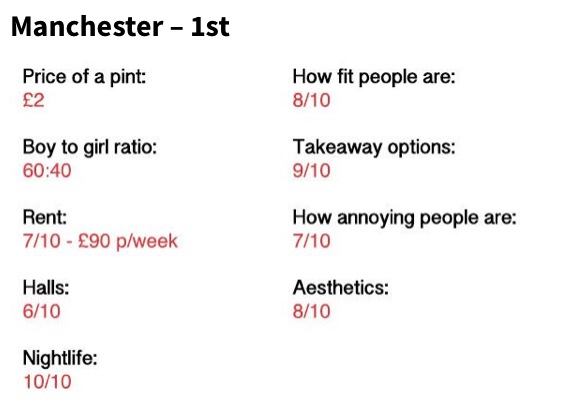The relentless march of league tables continues unabated.
Here at Wonkhe we have covered some of the bigger ones:
The UK’s first ranking of university car parking
The extraordinarily subtle free speech ranking
The Complete University Guide league table
And from last year…
The Times & Sunday Times ranking
THE’s world university ranking
As well as some of the really not terribly good ones as highlighted in the latest ranking of the dumbest rankings, there are several other recently published ones which we simply haven’t had the opportunity to report on here. So a brief summary of some of the recent rankings you may have missed:
I wrote it ten times or more
According to its webpage the Center for World University Rankings (CWUR) is a consulting organization providing “policy advice, strategic insights, and consulting services to governments and universities” and produces its own global league table: 
Since 2012, CWUR has been publishing the only academic ranking of global universities that assesses the quality of education, alumni employment, research output, and citations without relying on surveys and university data submissions. The ranking started out as a project in Jeddah, Saudi Arabia with the aim of rating the top 100 world universities. It was quickly reported worldwide by universities and the media and many requests were received to expand it. In 2014, the ranking expanded to list the top 1000 out of eighteen thousand universities worldwide, making it the largest academic ranking of global universities.
It doesn’t produce a radically different ranking with Harvard, Stanford, MIT, Cambridge, Oxford as the top 5 but it’s fair to say it lacks the impact of its rivals.
Strange fascination
But here’s a refreshing approach from the Tab which makes a bit of a change from ‘which ice cream is your uni?’
It’s that time of the year where all you see the annual university league tables. As per, Oxford and Cambridge always come on top with the usual London lot trickling behind.
But the problem with these rankings is they’re judged on boring shit like staff to student ratio, feedback satisfaction and whether you’ll get a career after six months after graduating. And correct me if I’m wrong, but who actually cares or judges a uni on any of those things?
No, instead what you care about is how cheap is a pint going to be if you go to Nottingham? How much carnage are the halls in Sussex? Are the rumours true that everyone in Newcastle is a 10/10???
Anyway, Manchester comes out on top and you can see how well they scored against the distinctive criteria:

Quality, I’m sure you’ll agree.
Little wonders
An excitingly innovative league table is offered by Reuters -which ranks Europe’s most innovative universities. This list has Belgium’s KU Leuven at the top with Imperial and Cambridge in 2nd and 3rd place. The table:
identifies and ranks the educational institutions doing the most to advance science, invent new technologies and power new markets and industries. A Dutch-speaking school based in Belgium’s Flanders region KU Leuven was founded in 1425 by Pope Martin V and continually produces a high volume of influential inventions. Patents filed by KU scientists are frequently cited by other researchers in academia and in private industry. That’s one of the key criteria in Reuters’ ranking, which was compiled in partnership with Clarivate Analytics, and is based on proprietary data and analysis of patent filings and research paper citations.
It’s certainly different.
You pretty things
And then there is the Hipster Index of the hippest cities across the globe:
Our new, improved, alternative Hipster Index combines five data points: the number of vegan eateries, coffee shops, tattoo studios, vintage boutiques, and record stores per 100,000 city residents. Combined and weighted they produce a Hipster Index score out of ten for each city. To prevent inflated numbers — and preserve our sanity — we excluded cities with populations below 150,000.
We looked at 446 cities across 20 countries. That’s 2,834 record stores, 7,772 vegan eats, 14,588 tattoo studios, 15,549 vintage boutiques, and 93,203 coffee shops covering a combined population of over 200,000,000 people. Serious. Bloody. Business.
Interesting criteria and big congratulations to Brighton for achieving peak hipsterdom.
Don’t let me hear you say life’s taking you nowhere
The THE has, in recent years, produced rankings for all occasions from the full world ranking to some very niche ones. The best universities under 50 years old is one of the more popular of these and has the advantage of changing every year. As a consequence though there is a need to provide for those universities which were once young but are now middle aged. Fortunately though THE are on it but rather than calling it something sharp like the ‘Mid-Life Crisis Ranking’ they have called it the ‘Golden Age’ league table:
The universities in the Times Higher Education “Golden Age” ranking were established between 1945 and 1967. The ranking takes its name from what was a Golden Age in global higher education, characterised by rapid university expansion and increasing investment in research.
Because of the age of these universities (more than 50 years old but under 80), they fall outside the parameters of our overall Young University Rankings that looks at institutions under 50 years of age. They make up a unique group of higher education institutions that have embedded academic practices but that have not been around for hundreds of years.
There are two appearances in the top 10 from the University of California System, with the University of California, San Diego topping the list and the University of California, Irvine in ninth place. The US has 14 universities in the ranking overall.
The UK’s sole representative in the top 10 is the University of Warwick. However, the UK has a strong presence in the ranking with 23 universities making the list, including the University of York, the University of Surrey and Keele University.
(After the Golden Age universities we then have the Ancients of course as covered here before.)
There you have it then, a handy round up of some of the rankings you have missed.
Do feel free to let us know if there are others we have overlooked.













